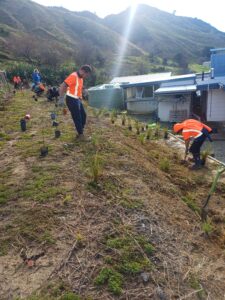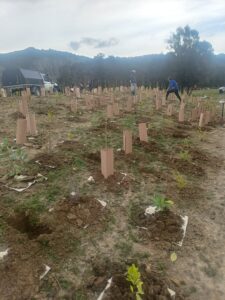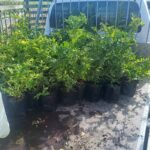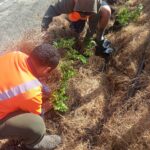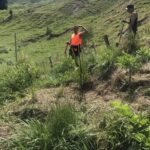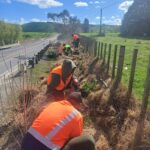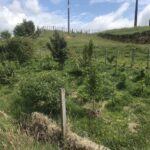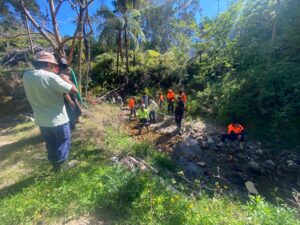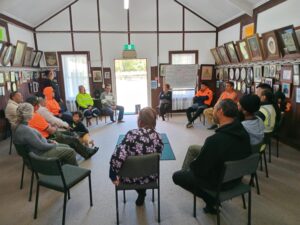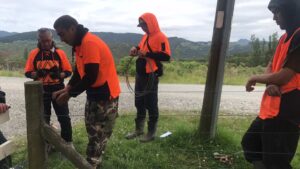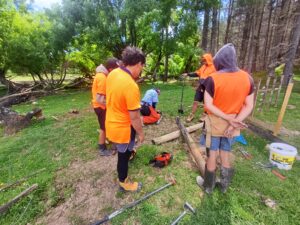This holistic project in Te Tairāwhiti has gone from strength to strength, with activities including wānanga, water monitoring, fencing and planting. Rangatahi are restoring habitats, reintroducing threatened plants, and boosting ecosystem resilience, while strengthening their connections to people and place. Te Aho Tū Roa Poutautoko Rawinia Kingi shares an update.
“It’s been incredible to see people come together, share ideas, and take action to protect our natural world. Throughout these initiatives, we’ve seen firsthand the positive impact that comes from connecting people, place, and the environment. We’ve witnessed friendships form, knowledge grow, and a deeper appreciation for the natural world develop.”
Whakatō Rākau Māori
We’ve been busy planting native trees in some amazing locations around the region, including Tikapa, Tokomaru, Waipiro, and State Highway 38.
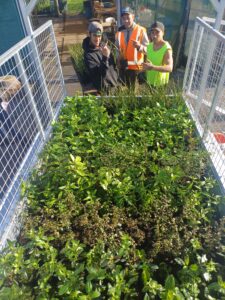
Huiterangiora crew members picking up natives purchased to plant out for the season
Before we started planting, we chatted with local hapū and landowners to make sure we were on the same page. This was a great opportunity to build some awesome relationships with hapū and landowners and to
- Figure out the best spots and species for our native tree planting
- Create a plan that worked for everyone involved So far, we’ve planted hundreds of native trees and shrubs, which will help bring back some of the region’s natural beauty.
We’re stoked to be:
- Creating new habitats for native birds, insects, and other wildlife
- Supporting sustainable land use practices and promoting environmental stewardship
- Giving nature a helping hand and making our region an even better place to live
Our native tree planting program has shown us just how important it is to work together with our communities to protect the environment. By doing so, we can spread awareness and education about the importance of conservation
- Get more people involved in looking after our natural spaces
- Create a more sustainable and resilient region for everyone
We’re looking forward to continuing our native tree planting efforts and involving more community members in the coming year. Let’s keep working together to make our region an amazing place to live!
- Waiparapara Marae, Tokomaru plant out – first for the season.
- Supporting whanau of Totaranui block with their planting efforts. Well organised and resourced
Ngutukākā
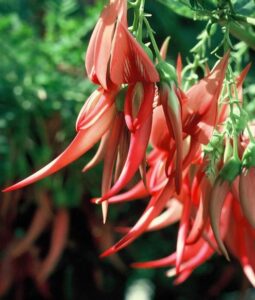
Ngutukākā/Kākābeak is named for its beautiful red flowers, which hang in clusters of 15-20 blooms and are shaped like the beak of a Kaka.
Ngutkākā Trust, and Huiterangiora Kōkiritia! have been working hard to bring back Ngutukākā/Kākābeak – along State Highway 35
We have fortunate to work alongside Graeme Atkins of Ngutukākā Trust and their vision to bring back the endangered Ngutukākā to Te Tairawhiti. Our goal is to support the establishment of a thriving population of Ngutukākā on SH35, and we’re making good progress. We’ve already planted numerous Ngutukākā seedlings in carefully selected locations and monitored and maintained the plants to ensure their health and survival.
By bringing back the Ngutukākā, we are supporting the cultural and spiritual significance of the species to local hapū. Fostering a sense of community pride and ownership in conservation efforts by those that planted them.
We’re committed to continuing this important work and seeing the positive impact it will have on Te Tairawhiti’s unique environment, not to mention the beautiful flowering red flowers back in its natural environment from his natural location of Hikuwai.
- Beautiful, healthy, lush Ngutukākā ready to be transported to new forever homes
- Planting out SH35 with the Ngutukaka that Graeme Atkins sourced from his local growers
- For the best chance at survival, maintenance is important. Out there weed whacking!
- The crew of Tairawhiti can expect a beautiful display of ngutukākā on their Sh35 Drive
- Maintenance on the ngutukaka planted on SH35, Hikuwa
Water monitoring – Waipiro
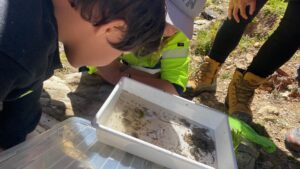
When you can capture interest of our new generation of kaitiaki, then your work here is done!
We have now completed three rounds of water monitoring, with aspirations to continue this important work.
Before any monitoring activities took place, we consulted with local hapū to ensure that our work was undertaken in a culturally sensitive and responsible manner. This consultation process allowed us to:
- Build relationships with hapū and gain a deeper understanding of their values and concerns,
- Ensure that our monitoring activities were aligned with hapū aspirations for the management of their ancestral waters,
- Obtain guidance on culturally appropriate protocols for monitoring and sampling.
Through our water monitoring efforts, we’ve gained valuable insights into the health of our local waterways. We’ve learned about:
- The importance of water quality for human health, recreation, and economic development,
- The impact of land use practices, such as agriculture and forestry, on water quality,
- Our water monitoring program has also highlighted the value of regular monitoring,
- Identifying trends and patterns in water quality.
We’re committed to continuing our water monitoring work, with plans to conduct further sampling and analysis in the coming year. By working together with hapū and the wider community, we can help ensure the long-term health and resilience of our region’s precious waterways.
- Connecting to their wai and learning monitoring techniques under the expertise of Mere Tamanui
- Hoki te marae, nohotahi me te whanau, hapū. A beautiful reminder of importance of whakpapa
Fencing – whakatū, whakatika taiapa
Our fencing projects have been a key part of our work over the past six months. Fencing is about more than just putting up a physical barrier, but taking a holistic approach to environmental management. We estimate that we have built 250m of a new fence line and up to 1-2km of fence repairs.
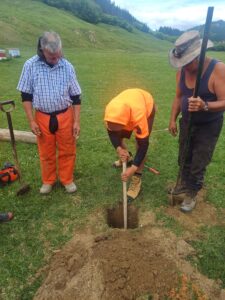
Ka pu te ruha, ka hao te rangatahi. transference of skills from one generation to the next. Priceless!
Through our fencing projects, we’ve learned about the importance of:
- Protecting sensitive ecosystems and habitats,
- Managing stock and preventing erosion,
- Enhancing biodiversity and promoting native species,
- Supporting sustainable land use practices.
We’ve also learned about the value of fencing as a tool for community engagement and education.
By working together on fencing projects, landowners, community members, and our team have shared knowledge, skills, and experiences. We’ve seen firsthand how fencing can be a catalyst for broader environmental and social benefits.
Our fencing projects have taught us that even the simplest actions can have far-reaching benefits when taken as part of a holistic approach to environmental management.
- Learning to tie off. Assessment for Primary Industries level 2 complete!
- Learning how to safely set up a new fenceline



